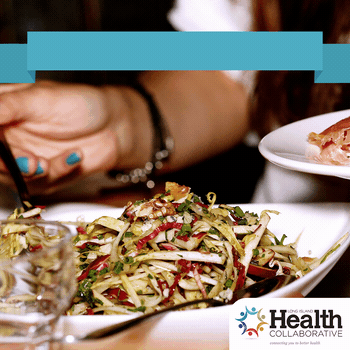Starting and maintaining a healthy lifestyle can be a challenge. It seems like each day we’re bombarded with the latest fad diet and exercise that are ‘guaranteed’ to lead to a healthier you. The truth is, by replacing those fads with sustainable lifestyle changes, living a healthier life becomes easier, and more effective.
At the Long Island Health Collaborative, our goal is to help Long Islanders be the best, healthiest version of themselves. We’ve broken down healthy lifestyle habits that will be most beneficial in the long run. What are you waiting for? Let’s dive in!

Healthy Eating (and How to Enjoy it!)
It’s important to begin with a balanced, healthy eating plan that includes options you’ll actually enjoy! What does a healthy diet consist of, you may ask? According to the Dietary Guidelines for Americans (2015-2020), a healthy diet plan includes:
- A wide variety of vegetables from all subgroups – dark green, red and orange, legumes (beans and peas), starchy, and other
- Fruits, especially whole fruits
- Grains, at least half of which are whole grain
- Fat-free or low-fat dairy, including milk, yogurt, cheese and/or fortified soy beverages
- A variety of protein foods, including seafood, lean meats and poultry, eggs, legumes, nuts, seeds, and soy products
- Heart-healthy oils
How to Set Yourself up for Healthy Eating Success
When it comes to healthier eating habits, it can be easy to only focus on the things that you are giving up, instead of something positive like, your end goal of better health and the way your body feels when you eat whole, nutritious foods. Rather than thinking of it as a negative, think about all of the wonderful things your body will be gaining. To transition into a positive mindset and set yourself up for healthy eating success, start with these minor adjustments:
- Prepare your own meals. Eating at home offers numerous benefits, including the opportunity to educate yourself on the food you buy, increased control of the food you include or don’t include in your diet based on your individualized wellness needs, better use of portion control and more cash back into your own pocket!
- Read the labels when grocery shopping. Do you know what to look for when reading food labels, and why it’s important? Read these tips to make sure you know how to understand food labels, so you can be in the driver’s seat as you build a heart-healthy meal plan.
- See how you feel before, during and after eating. This can also be recognized as a key principle of intuitive eating. This approach teaches and encourages you to honor your body’s hunger, make peace with food and respect your fullness.
- Eat smaller portions. Measuring and weighing your food are so critical in learning appropriate portion sizes. Do you know what the portion size “rules of thumb” are? For easy access to a cheat sheet for you to take with you to work or at home, print and carry this guide from the National Heart, Lung, and Blood Institute.
Long Island Restaurants with Healthy Meal Options
Curious about delicious places to eat healthy on Long Island? Try out these restaurants - you won’t be disappointed!
Bareburger
235 Merrick Road
Rockville Centre, NY 11570
OR
32 Middle Neck Road
Great Neck, NY, 11021
Skinny Pizza
211 Mineola Avenue
Roslyn Heights, NY 11577
The Purple Elephant
81 Fort Salonga Rd W, Ste 25A
Northport, NY 11768
Tula Kitchen
41-43 East Main Street
Bay Shore, New York 11706
631.539.7183
The Sexy Salad
160 Adams Avenue
Hauppauge, NY 11788
Farm Country Kitchen
513 W Main St
Riverhead, NY 11901
Tropical Smoothie Cafe
With more than 15 locations on Long Island, you’re sure to find one of these healthy-optioned cafes close to you!

In addition to healthy eating, physical activity is just as important to maintaining a healthy lifestyle. According to the CDC, adults need approximately 150 minutes (2 hours and 30 minutes) of moderate-intensity aerobic activity each week. But one of the hardest things to do is get started. Don’t back down from the challenge! Start somewhere achievable - one 30 minute workout a week is a great first step, and can grow into a more frequently active lifestyle.
If you’re looking for more local health resources, look no further! This list of Long Island gyms and organizations are sure to help you reach your new wellness goals.
If you’re interested in a low-cost, beginner-friendly, local gym, you can probably find a Blink Fitness or Planet Fitness near you. For as little as $10-$15 a month, you can access a ton of cardio machines, lots of easy-to-use strength training machines, and both franchise’s incredibly flexible hours.
HRHCare – A founding member of the Long Island Health Collaborative, HRHCare is a not-for-profit health center, full of resources to connect people and patients to necessary services. They’re here to make it easy for you and your family to get the healthcare you need.
Evolve Wellness – Another LIHC member, Evolve Wellness is health coach & personal trainer Lisa Zimmerman’s holistic approach to discovering new ways to shop, cook, eat and move. Look and feel good from the inside out with Zimmerman’s guidance, or with the help of a health coach recommended through a friend.
YMCA LI – Getting involved at your local YMCA will give you access to tons of healthy resources, from community sports to education, volunteer opportunities, counseling services, financial assistance, and more. Learn about what the YMCA, another Health Collaborative partner, can help you with today.
Local hospitals often have resources for members of their communities that range from weight loss programs to preventative health programs, to classes for soon to be moms and new moms, classes for the elderly, classes for chronic disease management, and more. Visit the website of your local hospital to find out what programs and classes are being offered near you.
Programmatic weight loss initiatives that create communities are a great way to find support for your healthy goals and motivation for your lifestyle changes. Weight Watchers is an in-person option for those who need to show up to be held accountable and need the incentive of membership. There are tons of regular meetings at Long Island locations to fit your busy schedule. Find a meeting near you! Or research free, online options like My Fitness Pal or Diet Bet, to determine the best option for your fitness and wellness goals.
Exercise 101
Just starting to incorporate physical activity into your routine? No problem! As a beginner, the best way to get moving is to take it at your own pace. Whether that means walking for 20-30 minutes after dinner throughout the week, walking the dog for that extra block or two, or parking farther away from your destination - every bit counts!
Looking for more easy ways to increase activity during your day? Check out our blog 11 Easy Tips to Help Increase Your Daily Activity.
Get Active on Long Island!
There is no doubt that Long Island provides a plethora of beautiful places to get active. From parks to beaches - the options are endless! Whether you want to take a stroll with the family over the weekend, or you just want to go and enjoy some alone time, these spots are sure to be a hit for all:

Sleeping Habits
Sleep habits can make a big difference to your health. At one time or another, everyone feels fatigued and drowsy during the day. This is often a direct result not getting enough sleep the night before. So how much sleep do people need? The CDC recommends:
- Newborns: 16-18 hours a day
- Preschool-aged children: 11-12 hours a day
- School-aged children: At least 10 hours a day
- Teens: 9-10 hours a day
- Adults (including the elderly): 7-8 hours a day
Healthy Sleeping Tips and Tricks
Do you get enough rest each night? Maybe you struggle to fall asleep? Certain bad habits can keep you from dozing off. The experts at the National Sleep Foundation recommends trying these sleep practices:
- Practice a calming bedtime ritual. Incorporate a relaxing activity into your bedtime routine. The ritual will give your body a better chance of relaxing, and decreasing stress and anxiety - two sleep barriers we all have.
- Have trouble sleeping? Avoid naps. Daytime power naps can be so tempting after a restless sleep., But if you’re having a hard time falling asleep at night, eliminating even the shortest nap can be beneficial.
- Ensure your sleep environment is designed for proper sleep conditions. It’s important to design your room for proper sleeping conditions. By ensuring a dark area, decreasing the temperature (between 60-70 degrees) and eliminating any noises or distractions, you’ll have a better chance of getting quality sleep.
- Exercise daily. Incorporating vigorous activity into your daily routine is great for a good night’s sleep. However, even light activity is beneficial for your sleeping habits, so try your best!
- Make sure you’re sleeping on a comfortable mattress and pillows. Comfortable and supportive mattress and pillows are crucial to a restorative rest. Most good quality mattresses have a lifespan of 9-10 years. If your mattress is getting close to that age- it may be time to get a new one.
Looking For Additional Healthy Resources?
We have you covered! From various member events to indoor/outdoor walking opportunities, and our easy-to-navigate Are You Ready, Feet?™ dashboard, the Long Island Health Collaborative has the tools necessary to make healthy living a breeze.
Learn more about the LIHC and how getting involved today will help you take the steps to a healthier you!